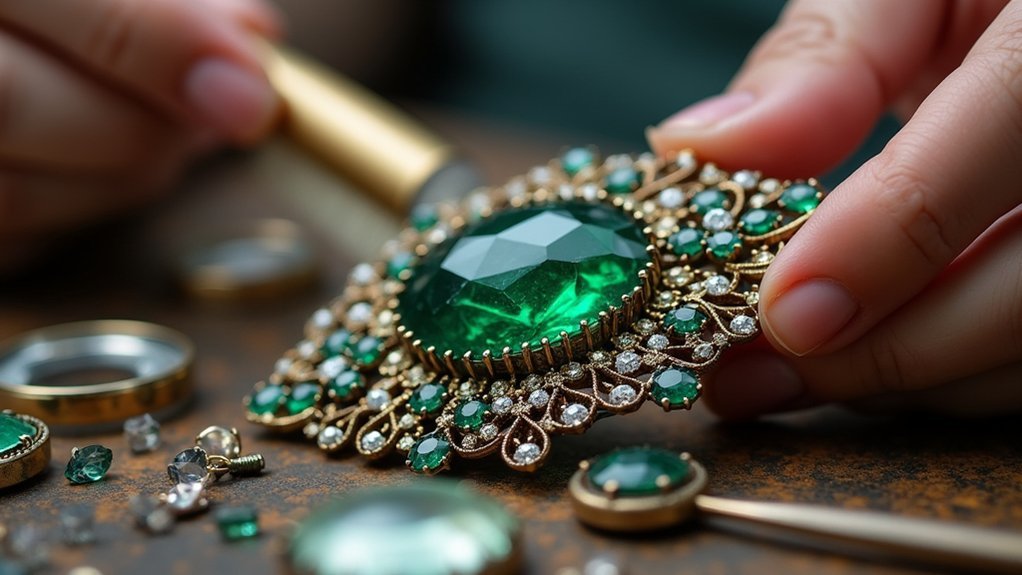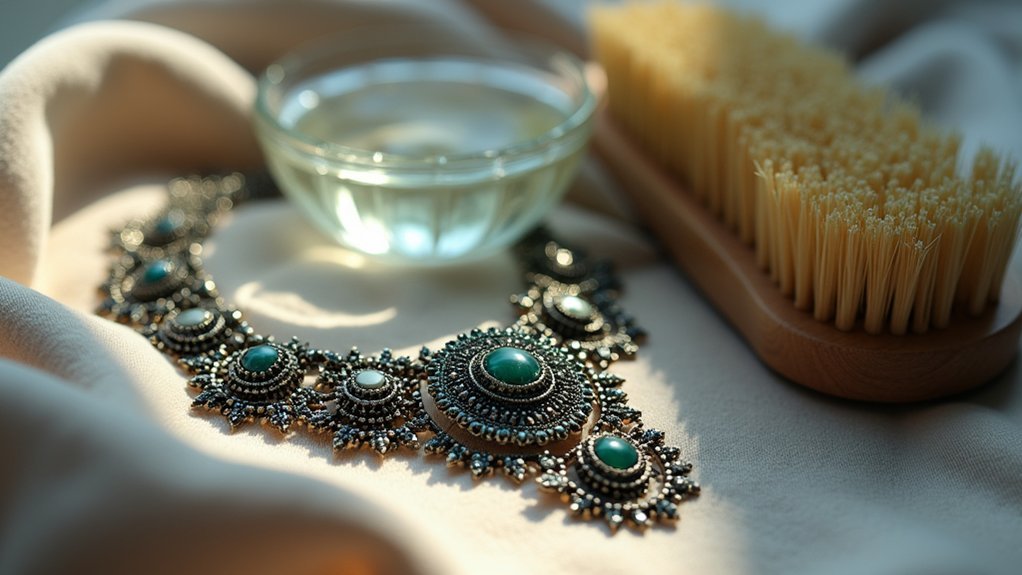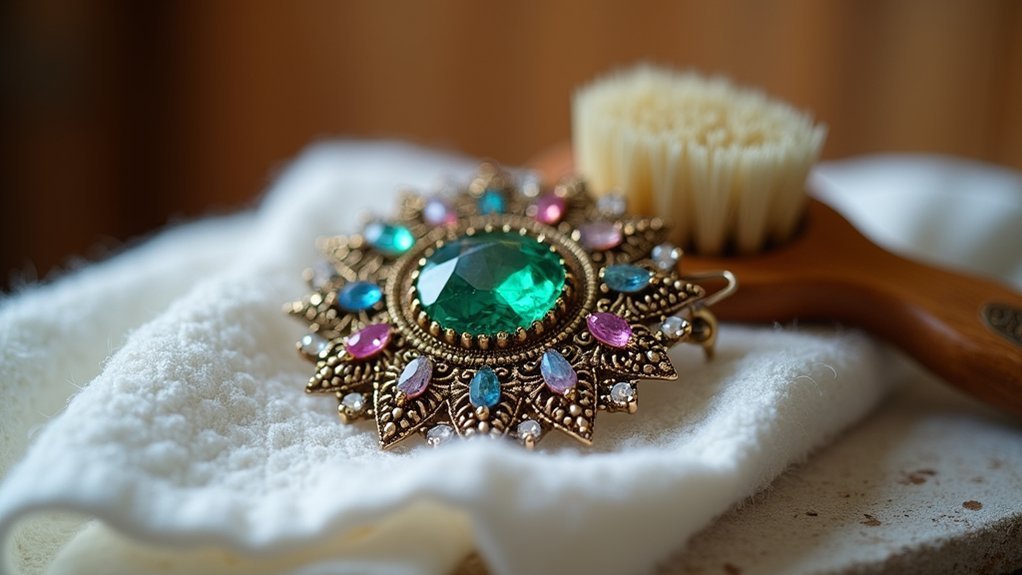To safely restore your vintage jewelry’s sparkle, start by identifying the materials through hallmarks and visual inspection using a jeweler’s loupe. Clean gold and platinum pieces with warm soapy water, while sterling silver responds well to mild soap or diluted baking soda. Wipe costume jewelry with a damp microfiber cloth, avoiding water submersion. For delicate stones like pearls and opals, use only a damp cloth and dry immediately. Avoid harsh chemicals, acids, and abrasive materials that can cause permanent damage. Proper techniques will reveal the full beauty of your treasured pieces.
Identifying Your Vintage Jewelry Materials and Gemstones

Before you begin any restoration work, you’ll need to accurately identify the materials and gemstones in your vintage piece. Start by examining your vintage jewelry for hallmarks or stamps that indicate metal type—look for “925” marking sterling silver’s 92.5% content.
Always identify your vintage jewelry’s materials first—examine hallmarks and stamps like “925” for sterling silver before starting any restoration work.
Study color and wear patterns to distinguish between gold varieties. Use a jeweler’s loupe to inspect gemstones for clarity, cut, and color characteristics.
Exercise special caution with soft stones like opals, pearls, and turquoise, as these delicate pieces require gentler cleaning methods. These materials can suffer damage from moisture or abrasive cleaners.
When you’re uncertain about identifying specific gemstones or metals, consult a professional jeweler for accurate assessment and appropriate care recommendations before proceeding with restoration.
Essential Preparation Steps Before Cleaning
Once you’ve identified your vintage jewelry’s materials and gemstones, you’ll need to take several essential preparation steps to guarantee safe and effective cleaning.
First, carefully inspect each piece for loose stones and fragile settings that could break during the cleaning process.
Next, gather your materials: a soft cloth, mild soap, lukewarm water, and a soft-bristled toothbrush.
Create a clean workspace free from contaminants that might stain your vintage pieces.
- Check for hallmarks and metal types to determine proper cleaning methods
- Examine settings and clasps for wear that might require professional cleaning
- Organize cleaning materials before starting to maintain focused attention on delicate jewelry
- Review manufacturer care instructions specific to your vintage piece’s era and construction
Safe Cleaning Techniques for Different Jewelry Types

Different jewelry materials require distinct cleaning approaches to preserve their integrity and appearance.
For gold and platinum pieces, you can safely use warm soapy water since these delicate metals rarely tarnish. However, gold-plated vintage pieces need only a damp polishing cloth to prevent damage.
When working with sterling silver, apply a mild soap solution or diluted baking soda mixture to remove tarnish effectively. Use a soft brush to gently scrub intricate designs, but avoid water completely when cleaning costume jewelry.
Instead, wipe these pieces with a damp microfiber cloth to protect adhesives and paint. For porous stones like pearls and opals, never soak them in cleaning solutions.
Simply wipe with a damp cloth and dry immediately to restore your vintage jewelry’s original beauty.
Proper Drying and Polishing Methods
After completing the cleaning process, you’ll need to dry your vintage jewelry thoroughly using a lint-free cloth to prevent moisture damage and future tarnishing.
Proper drying with lint-free cloths is essential to prevent moisture damage and maintain your vintage jewelry’s pristine condition.
This gentle cleaning approach protects your precious pieces from unnecessary wear.
When polishing, use a specialized polishing cloth designed for silver to restore luster without scratching metal surfaces. Instead of rubbing aggressively, lightly tap components to protect delicate parts from damage.
For gemstones, employ soft fabric slightly dampened with professional cleaning solution.
- Tap, don’t rub: Light tapping motions preserve intricate details and prevent scratching
- Avoid over-polishing: Excessive polishing wears down delicate finishes and ornate designs
- Use appropriate tools: Silver-specific cloths and professional solutions guarantee safe restoration
- Dry thoroughly: Complete moisture removal prevents corrosion and maintains your vintage jewelry’s integrity
Common Cleaning Mistakes That Damage Vintage Pieces

You’re likely making critical errors that can permanently destroy your vintage jewelry’s value and beauty.
Harsh chemicals like bleach will strip away metal finishes and erode gemstone surfaces, while improper soaking in acidic solutions such as vinegar or lemon juice causes irreversible discoloration.
These seemingly harmless cleaning methods can turn your cherished heirloom into a damaged piece that’s beyond repair.
Harsh Chemical Damage
While household cleaners might seem like convenient solutions for restoring shine to vintage pieces, they’re often the fastest route to permanent damage.
Harsh chemicals like bleach and ammonia cause permanent discoloration and corrosion that can’t be undone. Acidic substances deteriorate delicate materials, particularly affecting soft metals and gold-plated finishes.
Abrasive agents scratch and dull surfaces, while soaking vintage jewelry loosens stones and weakens fragile settings.
- Chemical corrosion: Bleach and ammonia create irreversible metal damage
- Acidic deterioration: Lemon juice and vinegar destroy protective finishes
- Surface scratching: Baking soda and toothpaste dull precious metals permanently
- Structural weakening: Household cleaners degrade adhesives in costume pieces
Understanding these risks helps you avoid costly mistakes when attempting to restore your treasured vintage jewelry through proper cleaning methods.
Improper Soaking Methods
Beyond chemical damage, improper soaking techniques pose equally serious threats to vintage pieces.
You’ll risk permanent damage when cleaning vintage jewelry with household solutions like lemon juice or vinegar, which discolor soft metals and delicate finishes.
Never submerge pieces containing porous stones such as pearls or opals—moisture absorption causes irreversible deterioration.
Boiling water warps delicate components and weakens glued settings, while abrasive agents like baking soda scratch surfaces and eliminate original luster.
When cleaning antique jewelry, avoid damaging techniques that don’t consider specific materials and construction methods.
To restore tarnish safely without harsh chemicals, consult professional jewelry experts who understand vintage piece requirements and can recommend appropriate jewelry cleaner alternatives.
Professional Care and Long-Term Maintenance Tips
Although vintage jewelry restoration requires skill and patience, maintaining these precious pieces long-term demands equally careful attention to professional care and proper storage practices.
Preserving vintage jewelry’s beauty requires the same meticulous care and expertise that went into its original creation.
You’ll need to schedule professional cleaning for valuable pieces, allowing experts to carefully restore intricate details while preserving their original condition. A qualified jeweler provides the best solution for complex repairs, ensuring your delicate jewelry maintains its integrity.
Your regular maintenance routine should focus on gentle methods that avoid damage to precious gemstones and settings. Store pieces in soft pouches within cool, dry environments to prevent tarnishing and scratches.
- Schedule professional cleanings annually for intricate or valuable vintage pieces
- Store jewelry in lined boxes or soft pouches away from moisture and direct light
- Limit cleaning frequency to prevent over-polishing that wears down delicate surfaces
- Choose qualified jewelers experienced with vintage pieces for all repairs and restorations
Frequently Asked Questions
How Do I Make My Jewelry Sparkle Again?
Use a mild soap solution with lukewarm water to gently clean your jewelry. Polish silver and gold pieces with a jewelry cloth using circular motions. Apply protective sealant afterward to maintain sparkle longer.
How to Bring Old Jewelry Back to Life?
You’ll revive old jewelry by first identifying its materials, then gently cleaning with mild soap solution and soft brush. Polish tarnished metals carefully, rinse thoroughly, dry completely, and store properly to maintain restored brilliance.
How to Safely Clean Vintage Jewelry?
You’ll want to identify your jewelry’s materials first, then create a mild soap solution with lukewarm water. Gently scrub with a soft toothbrush, rinse carefully, and dry completely with lint-free cloth.
How to Remove Oxidation From Jewelry?
You’ll create a mild soap solution with warm water, then gently scrub oxidized areas using a soft-bristled toothbrush. For silver pieces, use specialized silver cleaners or polishing cloths to effectively remove tarnish.
In Summary
You’ve learned the essential skills to safely restore your vintage jewelry’s brilliance. By identifying materials correctly, preparing thoroughly, using appropriate cleaning techniques, and avoiding common mistakes, you’ll preserve your precious pieces for years to come. Remember that patience and gentle care are your best tools. When in doubt, don’t hesitate to consult a professional jeweler. Your vintage treasures deserve the careful attention that’ll keep them sparkling beautifully.





Leave a Reply